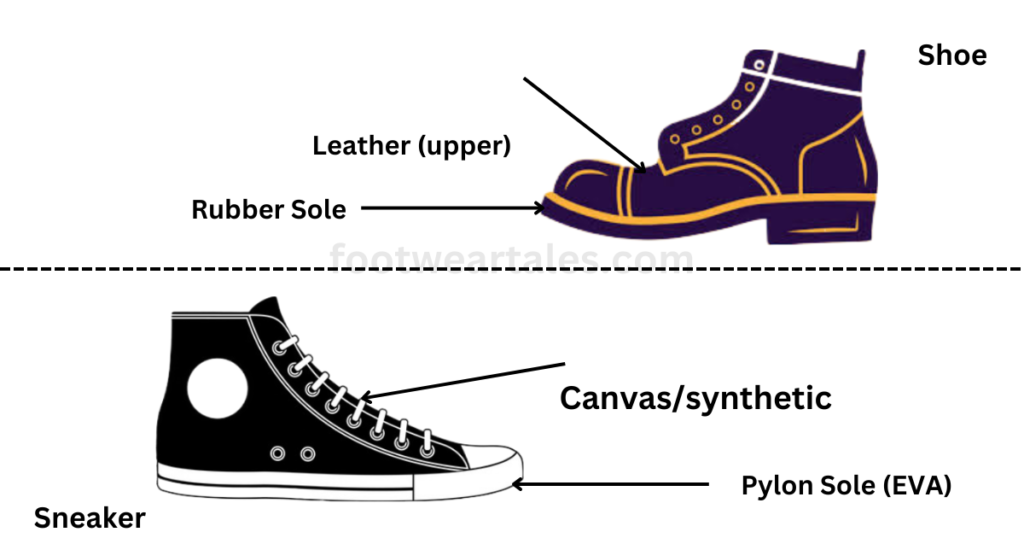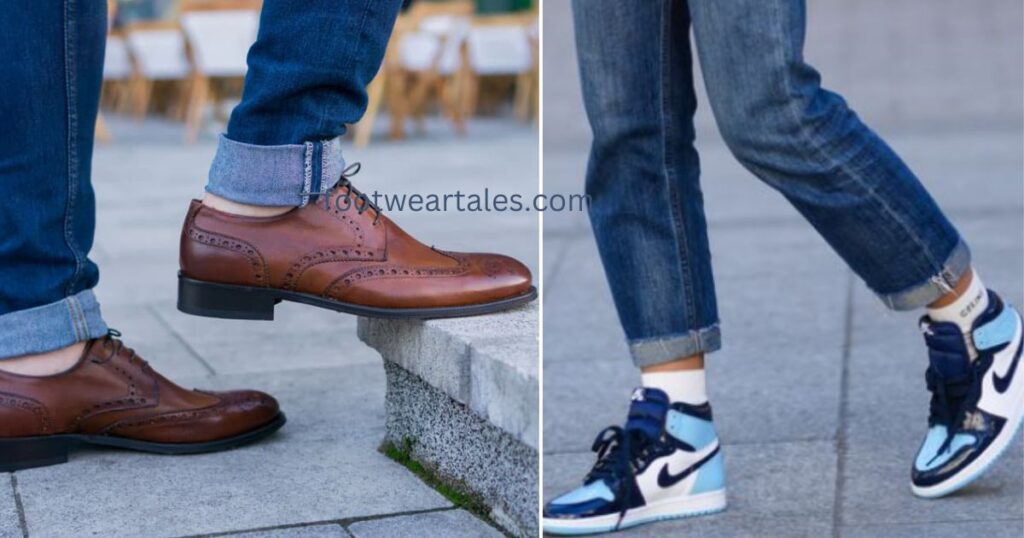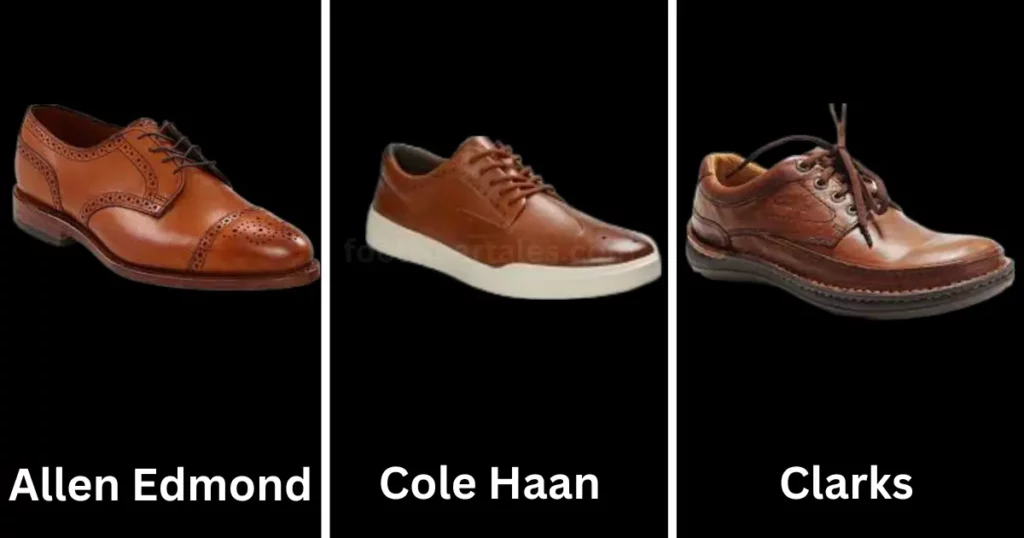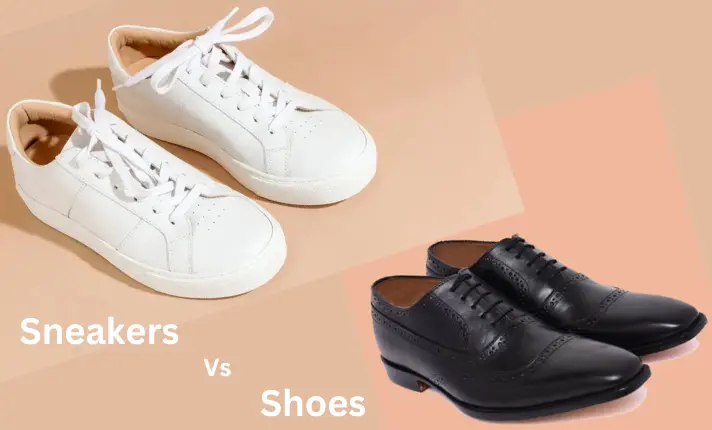Sneakers vs Shoes: The Ultimate Battle of Footwear Dominance
One day, I went shopping for a new pair of shoes. While browsing through the aisles, I came across a sneaker section and decided to try on a pair. They were comfortable, lightweight, and had a sporty design. Intrigued by their unique features, I compared them to a pair of shoes I had worn for years. The shoes were sturdy and formal-looking but lacked the flexibility and cushioning of the sneakers.
This made me realize that sneakers differ from traditional shoes regarding functionality and purpose. From then on, I started appreciating the versatility and comfort that sneakers offer in various activities like sports or casual outings. The terms sneakers and shoes are often used interchangeably, assuming they mean the same things. However, understanding the difference between sneakers and shoes is crucial for fashion enthusiasts and athletes.
So step into the ring as we witness a showdown between two iconic contenders – sneakers and shoes. In one corner, we have the stylish, street-smart sneakers that have taken the fashion world by storm. And in the other corner, we have the classic, timeless shoes that have stood the test of time. Get ready to explore their origins, delve into their unique features, and ultimately decide which will reign supreme in this epic clash of foot fashion.
The Major Differences Between Sneakers And Shoes

| Sneakers | Shoes |
Sneakers typically have rubber soles that provide excellent shock absorption and flexibility, making them ideal for much movement or impact activities. | Shoes often feature a more rigid sole made from leather or synthetic materials, offering excellent stability and durability. |
| Sneakers are known for their casual appeal and athletic-inspired design. | Shoes typically have a more formal look with sturdy leather or suede uppers and rugged leather soles, making them suitable for dressier occasions. |
What’s considered a Shoe?
Shoes serve a dual purpose: safeguarding your feet and providing comfort while engaging in diverse activities. Beyond functionality, it also serves as an outlet for self-expression through its many styles and designs. While traditional materials like leather, wood, and canvas were once prevalent in shoe production, modern times have ushered in new materials such as rubber and petrochemical-derived substances like plastics.
The extensive shoe types include formal footwear for professional settings, athletic shoes tailored for running or sports-related pursuits, and casual options for everyday wear. The nature of one’s occupation or hobbies often necessitates specialized footwear; individuals involved in physically demanding jobs like ironworking require high-quality work boots, while avid runners benefit from investing in top-notch running shoes.
Making informed decisions about footwear selection requires understanding the distinctions between sneakers and shoes – knowledge that will guide individuals toward choosing the most appropriate option based on their needs.
People appreciate shoes because of the low maintenance requirement; a quick wipe with a damp cloth effortlessly removes dirt particles without significant time or effort.
What’s considered a Sneaker?
The word sneaker may evoke an image of soft footsteps or even mischief, but its origins lie in a practical concept. In the 1800s, sneakers were initially called sneaks, derived from the English word snick, meaning to creep silently. These early rubber-soled shoes gave wearers stealthy footsteps ideal for sneaking undetected. However, it was not until the late 19th century that they earned their name as we know it today.
Originally designed for sports or physical exercise, sneakers have now become a popular choice for everyday casual wear due to their comfortable and relaxed design. These versatile shoes suit various purposes, such as walking or running.
Sneakers come in various styles and are crafted from various materials, including leather and plastic. They can be effortlessly paired with any clothing, even for more formal occasions. With their rubber or synthetic construction, sneakers offer easy slip-on functionality and exceptional comfort thanks to the added cushioning. You can find sneakers available at any shoe store.
Difference between Sneakers and Shoes
| Features | Sneakers | Shoes |
| Durability | The lightweight design may result in less durability compared to shoes. | Shoes are more durable than sneakers |
| Functionality | Flexible and well-suited for diverse activities and purposes. | It is more appropriate for a formal and professional environment. |
| Price | A wide range of choices is available, from affordable to high-end luxury. | Usually more expensive than sneakers |
| Environmental impact | might use more carbon-intensive production techniques. | can also have a major effect on the environment |
| Popular brands | Adidas, Puma, Nike, Reebok, Vans, and Converse | Dr. Martens, Timberland, Allen Edmond, Cole Haan, Clarks |
| Types | Sporty, trendy, efficient | Dress, informal, relaxed, sporty |
| Maintenance | Consistent cleaning and proper storage are necessary. | It is necessary to clean, polish, and store regularly. |
| Trend and Style | Currently ruling the fashion industry | A must-have for formal events and professional environments. |
While both sneakers and shoes fulfill our need for footwear, they diverge significantly in their design philosophy regarding function versus style and their overall cultural significance. Understanding these key difference parameters can help us make more informed choices when selecting footwear that suits our needs and preferences.
Having experience with sneakers and shoes, I can confidently assert that there are distinct variations in comfort, support, style, durability, practicality, cost-effectiveness, and environmental footprint.
Comfort Level
When it comes to footwear, paying attention to comfort level is crucial. Each pair of sneakers and shoes has advantages and disadvantages because there is a difference between sneakers and shoes.
| Sneakers | Shoes |
| Sneakers are specifically crafted to ensure maximum comfort for wearers, incorporating cushioned soles, breathable materials, and flexible designs that enable natural movement. | Due to their glossy designs and more rigid materials, dress shoes offer less comfort than athletic shoes, designed with specialized cushioning and supportive features that make them more comfortable. |
| They have gained fame for being the go-to option for everyday wear and athletic activities. | Due to their glossy designs and harder materials, dress shoes offer less comfort than athletic shoes, designed with specialized cushioning and supportive features that make them more comfortable. |
Support and Protection
Regarding support and protection, sneakers and shoes offer different pros and cons.
| Sneakers | Shoes |
| Support is a major consideration in the design of sneakers, especially for multi-footed sports like basketball and running. | Dress shoes certainly fall short when providing the same level of comfort and stability as sneakers. |
| They offer arch support, reinforced soles, or specific padding to safeguard the feet against impact. | Shoes provide more stability and a more formal appearance. |
Fashion and Style

| Sneakers | Shoes |
| Sneakers have sporty aesthetics and casual appeal. | Shoes exude a timeless elegance that elevates any outfit to new heights of sophistication |
| Sneakers have also become symbols of individuality and self-expression through the many colors, patterns, and collaborations available in the market. | There may be less style and fashion versatility in shoes, especially dress shoes. |
Durability and Longevity
Shoes typically outperform sneakers when it comes to durability and longevity.
| Sneakers | Shoes |
| Sneakers tend to be made with softer, synthetic materials, making them more prone to wear and tear over time. | Shoes are typically crafted with sturdier materials like leather or canvas, allowing them to stand up against daily use and harsh conditions. |
| High-quality athletic sneakers designed for sports like running or hiking often feature reinforced soles and materials that resist abrasion, ensuring they can withstand the demands of intense physical activity. | They can be crafted with meticulous attention to detail, incorporating reinforced stitching or durable soles to enhance their longevity. |
Functionality
Depending on the situation, sneakers and shoes can offer distinct benefits in terms of functionality and usage.
| Sneakers | Shoes |
| Sneakers are known for their athletic appeal and are designed to provide maximum comfort and support during physical activities. | Shoes offer a more formal and polished look. |
| Sneakerheads now consider their sneaker collection not only athletic gear but valuable pieces of art that express unique personalities. | Shoe manufacturers have recognized the demand for comfort without compromising style by incorporating more athletic elements. |
Price and Value
| Sneakers | Shoes |
| Sneakers hold an intangible value beyond their physical attributes. They connect us to cultural movements and evoke nostalgia by representing different eras or distinctive subcultures. | Shoes are designed to withstand everyday wear and tear, making them a practical and cost-effective choice in the long run. |
| Sneakers, often associated with trendy brands and limited editions, can have a hefty price tag. | Traditional shoes may not have the street cred of sneakers but they can offer exceptional quality at a more affordable price. |
Choosing between a sneaker and a shoe has merits; it’s all about finding what resonates best with your tastes and needs.
Environmental Impact
| Sneakers | Shoes |
| Sneakers, often made with synthetic materials and non-biodegradable rubber soles, contribute significantly to pollution and waste accumulation. | Traditional shoes tend to be manufactured using more sustainable materials like leather or canvas, which can easily decompose after disposal. |
Choosing sneakers and traditional shoes should be based on personal preferences while considering their environmental implications.
By opting for ethically produced footwear or exploring eco-conscious options within sneaker culture, we can positively impact reducing waste and supporting sustainable practices across the industry.
Trends of Sneakers vs Shoes
Sneakers:

Sneakers have come a long way from being just athletic footwear to establishing themselves as fashion staples.
One of the recent trends in the sneaker world is the rise of collaborations between sneaker brands and artists, musicians, and even luxury fashion houses.
The limited edition releases generated by these collaborations often sell out within minutes, creating a frenzy among collectors who eagerly snatch up these exclusive kicks.
The Retro Sneakers trend has gained a lot of popularity. Brands like Nike, Adidas, and New Balance have been digging into their archives to revive old-school silhouettes that evoke nostalgia for many sneakerheads. This trend highlights the cyclical nature of fashion trends, where what was once popular decades ago finds its way back into the mainstream again.
Over recent years, sustainability has become an essential factor in the sneaker industry’s development.
This innovative approach addresses growing concerns about waste generation and appeals to consumers who value sustainable products without compromising style or performance.
Shoes:

Currently, the prevailing shoe trends prioritize comfort and adaptability. The rising popularity of fashionable yet comfortable casual shoes, such as loafers and slip-on shoes, exemplifies this. Similarly, even dress shoes embrace more comfortable designs with features like memory foam insoles and flexible materials.
One major trend in recent years is the rise of sustainable and eco-friendly footwear options. As consumers become more conscious about the environmental impact of their choices, many shoe brands are responding by using recycled materials and implementing sustainable production practices. These shoes not only look stylish but also help to reduce waste and minimize carbon footprints.
Styling Sneakers and Shoes for Different Occasions
Let’s discuss the art of styling sneakers and shoes for various occasions, as adhering to these styles will undoubtedly enhance your elegance and fashion sense. And there is, again, a difference between sneakers and shoes in terms of styling.
Sneakers:
- For a casual day out, pair your sneakers with distressed jeans and a graphic tee for an effortlessly cool look.
- When dressing up for a night out, sneakers can still be the center of attention. Opt for sleek, all-black sneakers and pair them with a tailored suit or a little black dress. This unexpected combination will make you stand out and stay comfortable throughout the night.
- For more formal occasions like weddings or cocktail parties, choose low-top white sneakers made of premium leather or suede. Style them with tailored trousers or an A-line dress to create an unexpected mix of elegance and sportiness. Complete the look with delicate jewelry and a clutch bag to enhance the polished feel.
Shoes:
- For a job, choosing closed-toe pumps or loafers is ideal for men regarding work footwear.
- Men can enhance their sophisticated look with sleek black Oxfords, classic brogues, patent leather Oxfords, or leather loafers for formal, wedding, or corporate events.
- Loafers are the perfect footwear for casual wear, offering comfort and style.
Well, there are many ways to style your shoes; if you want to seek more guidance on how to style dress shoes, you can visit here.
Future of Sneakers and Shoes
The future again depicts a difference between sneakers and shoes, which is undoubtedly exciting, with the industry constantly pushing design, technology, and sustainability boundaries. One prominent trend in the coming years is integrating smart features into footwear.
Brands like Nike and Adidas have introduced smart sneakers that track your steps, monitor your performance, and even adjust their fit accordingly. As technology advances rapidly, we can anticipate more innovative features being incorporated into our favorite pairs of kicks.
Popular Brands of Sneakers

As someone deeply passionate about sneakers, I can assert with certainty that there is an overwhelming abundance of options available regarding well-known brands.
The global giants have dominated the sneaker market for years, constantly pushing the boundaries of innovation and style. Top sneaker brands like Nike, Adidas, and Converse are in high demand.
Nike
From Michael Jordan‘s iconic Air Jordans to the timeless Air Max series, Nike has consistently pushed boundaries and set trends. What sets Nike apart is its sleek designs, innovative technology, and ability to maintain a strong connection with athletes and sneaker enthusiasts.
Adidas
Adidas – is known for its cutting-edge designs, combining fashion-forward aesthetics and functionality. Collaborations with artists like Kanye West through their Yeezy line have skyrocketed Adidas’ popularity among sneakerheads worldwide.
Converse
One brand of sneakers that has stood the test of time is Converse. Known for its iconic Chuck Taylor All-Star shoes, Converse has become a staple in the sneaker world. Converse’s uniqueness is its ability to appeal to a wide range of people, from athletes and musicians to fashion enthusiasts. The classic design and simple yet versatile style of Converse sneakers make them a go-to choice for many.
Types of Sneakers
A wide range of sneaker categories are available, allowing individuals to select based on personal preferences and needs.
Athletic Sneakers
Athletic sneakers have become a ubiquitous footwear choice, gaining popularity among athletes and fashion-conscious individuals. These shoes often come in lightweight designs, prioritizing flexibility and responsiveness for optimal performance.
Athletic sneakers include running shoes, basketball shoes, and cross-training shoes.
Fashion Sneakers
Fashion sneakers have become a popular trend in recent years. These sneakers are designed to be both stylish and comfortable, making them perfect for everyday wear. From sleek all-white designs to bold prints and patterns, fashion sneakers offer endless options for individuals looking to make a statement with their footwear.
Renowned for their trendy footwear, Vans, Puma, and Reebok stand out as notable brands in the fashion industry.
Performance Sneakers
Performance sneakers are a must-have for athletes and fitness enthusiasts looking to maximize their training sessions. These shoes offer style and functionality through lightweight materials, breathable fabrics, and specialized cushioning for physical activities.
APL Under Armour, Hoka One One, and other well-known performance sneaker brands are widely favored by consumers.
Popular Brands of Shoes

Whether you are searching for the ideal footwear for a special occasion or your daily activities, rest assured that there is a shoe style to match every taste.
Take your pick from well-known brands like Clarks, Cole Haan, and Allen Edmonds, which are highly sought after in the market.
Clarks is renowned for its comfortable and trendy casual footwear.
Cole Haan is celebrated for their top-notch formal shoes and groundbreaking designs. They joined forces with Nike to develop dress shoes incorporating athletic-inspired comfort technology.
Allen Edmond has built a solid reputation for producing high-quality shoes that are stylish and durable. Their commitment to using premium materials and employing traditional shoemaking techniques results in shoes that exude an old-world charm while meeting modern-day standards of comfort.
Types of Shoes
There are plenty of shoe types available for various occasions.
Dress Shoes
Dress shoes go beyond just finding something that fits well and looks good – it is about selecting high-quality craftsmanship that reflects your style and makes you feel confident in any formal situation. They are used in formal events such as weddings or business meetings.
Among the various options for dress shoes, Oxfords, Loafers, and Derby Shoes stand out as particularly popular styles.
Casual Shoes
Casual shoes have become a wardrobe staple for both men and women, offering comfort without compromising style. They can effortlessly transition from a day at the office to an evening out with friends. They have many styles, including loafers, and can be crafted from materials like leather, canvas, or suede.
Casual shoes like Boat Shoes, Driving Moccasins, and Slip-On shoes are widely favored by many.
Conclusion
The debate between sneakers and shoes ultimately comes from personal preference and individual needs. Sneakers offer comfort, support, and flexibility, making them ideal for athletic activities and casual wear. On the other hand, shoes provide a more formal and sophisticated look, suitable for professional settings or special occasions.
Both options have advantages and disadvantages, so it is essential to consider the specific purpose and context before deciding. Ultimately, the most critical factor is finding footwear that fits well, feels comfortable, and meets your unique style and lifestyle needs. So whether you choose sneakers or shoes, make sure they are a perfect fit for you!
FAQ’s
What can I do to prolong the lifespan of my shoes?
Are sneakers more comfortable than regular shoes?
Sneakers are often designed with additional cushioning and support, making them more comfortable for prolonged use than regular shoes.
Can I wear sneakers for formal occasions?
While sneakers have become more acceptable in certain casual or semi-formal settings, they are not traditionally worn for formal occasions. It’s best to opt for dress shoes in such situations.
What can I do to prolong the lifespan of my shoes?
Taking good care of your shoes through regular cleaning and protection, keeping them in a cool and dry environment, and avoiding excessive wear and tear can significantly extend their lifespan. Opting for well-made shoes can also contribute to their longevity.
Are synthetic materials less durable than leather in shoes?
Leather shoes have a longer lifespan than synthetic ones. Made from natural materials; leather can withstand the test of time and mold your foot for enhanced comfort. Conversely, top-notch synthetic materials offer durability and stability.
Is there a different term that can be used to refer to sneakers?
Fashion and sneaker enthusiasts often use these words, which convey a feeling of elegance and flair. Sneakers are called trainers, kicks, runners, and joggers in various circles.
How should I clean my sneakers or shoes?
Cleaning methods vary depending on the material of your footwear. Sneakers can often be cleaned using mild soap, water, and a soft brush, whereas certain shoes may require specialized or professional cleaning.




